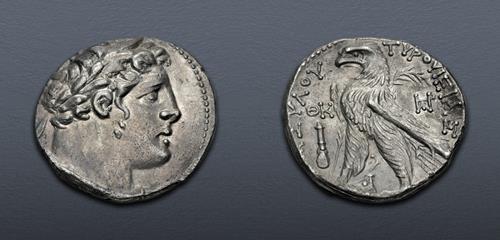|
PHOENICIA, Tyre. 126/5 BC-AD 65/6. AR Shekel (29mm, 14.30 g, 12h). Dated CY 29 (98/7 BC). Laureate head of Melkart right, lion skin around neck / Eagle standing left on prow, palm frond in background; to left, ΘK (date) above club; monogram to right, Phoenician B between legs. DCA-Tyre 100; HGC 10, 357; DCA2 946. Deep iridescent tone, a few minor marks, a little porosity, patch of roughness on reverse. Good VF.
One of the great cities of Phoenicia, Tyre was founded on an island just off the Levantine coast circa 2750 BC and rose to wealth and prominence from its extensive trade network and colonies, including Carthage. Effectively autonomous, it paid only tacit tribute to the Assyrian, Neo-Babylonian and Persian Empires before Alexander the Great arrived in 332 BC. Confident in their defenses, the civic leaders offered only to remain neutral in the conflict and refused Alexander entry to its famous Temple of Melkart. When he tried negotiations again, his envoys were slain and thrown from the walls. Enraged, Alexander subjected Tyre to a titanic seven-month siege. The causeway he built from the mainland to the island citadel forever altered the city’s geography, turning the island into a peninsula. After taking savage reprisals on the city’s populace, he pardoned King Azemilkos and returned him to the throne as a client king to Macedon. Upon Alexander’s death in 323 BC, Tyre was subject first to the Ptolemies and then the Seleukids and was an important mint for both dynasties. The city received a grant of autonomy from the Seleukid crown in 126/5 BC. Tyre immediately inaugurated a new civic coinage dated to the era of its autonomy, with certain affinities to the coinage it had formerly minted for its royal masters. The civic silver featured a new obverse type, a head of the local god Melkart, but the reverse type of an eagle standing on a prow was identical to the reverse of Tyre’s Seleukid coinage, which in turn had been an elaboration on the Ptolemaic eagle. Tyrian shekels and half-shekels continued to be minted until about AD 66. They circulated in Judaea and were used by the Jews to pay their annual Temple dues. The infamous “30 pieces of silver” paid to Judas for betraying Jesus would also have been Tyrian issues. This shekel was minted more than a century before the crucifixion, but is likely similar in type to the Biblical “30 pieces of silver.”
The final winners of all CNG Feature Auction 129 lots will be determined during the live online sale that will be held on 13-14 May 2025. This lot is in Session One, which will begin 13 May at 9 AM ET.
Winning bids are subject to a 22.5% buyer's fee for bids placed on this website and 25% for all others.
We recognize that our users may have various Internet Browsers and Operating Systems. We like our visitors to have the best possible experience when using our bidding platform. However, we do recognize that it is impossible to develop applications that work identically, efficiently and effectively on all web browsers. The CNG bidding platform supports the latest stable major version and stable previous version of Chrome and Firefox.
|
